
Wine Culture and Information since 2002 - Volume 22
 Wine Culture and Information since 2002 - Volume 22 |
|
Contrasts of Alto Adige Pinot Nero and ConeroTwo territories and two very different grapes compared in the glasses of this month's tasting by contrast. Pinot Noir and Montepulciano, South Tyrol and Conero, from the enological point of view, are in fact two distant worlds, practically opposite. |
|
Over the last recent years, in this column, we have proposed tastings of wines produced with decidedly different grapes, not least, originating from geographically distant territories, therefore different in any aspect. The tasting by contrast that we are about to propose certainly belongs to this kind of study, as both the grapes and territories have nothing in common. Although this type of tasting may be considered too simple, in reality it represents a very important chance of study for the training of the taster. Indeed, it is thanks to these distant differences the study of the elements of comparison – the two wines, in our case – become more easily and clearly definable and understandable. As soon as the qualities of the individual varieties are learned, including their respective territorial expressions, their recognition and study in sensorial terms becomes more “simple”, despite the concept of sensorial simplicity is – in itself – very complex and vast. In this sense, the value of memory, together with continuous practice, become decisive for the taster's training, regardless of the element being studied, wine in our case. The wines we will pour this month into the glasses, in fact, are produced with Pinot Noir – the undisputed king of elegant and fine wines – and Montepulciano, equally and not least “king”, with a powerful character and huge personality. To this we add two very different territories: Alto Adige (South Tyrol) and Conero. The former is located in the Alpine and pre-Alpine territory of Italy – therefore rather high altitudes and a decidedly “cold” climate – the latter is found in the homonymous promontory of the Marches region and strongly affected by the influence of the Adriatic Sea. In the glasses we will therefore have two very different wines however very interesting in their individual sensorial and territorial expressions, such as to highlight the respective differences in clear and indisputable evidence.
|
|
Pinot Noir is an extraordinary grape, capable of creating wines of absolute elegance and unattainable class. But it is also a very difficult grape to grow and, not least, to make wine from it, as it is demanding in every aspect, from the vineyard to the glass. Moreover, Pinot Noir is also particularly demanding in environmental and cultural terms, a primary and fundamental requirement for making a great wine with this variety, regardless of the style. In this sense, it can be said that – in the world – there are very few Pinot Noir lands and, among them, South Tyrol can certainly be considered one of them in Italy. Burgundy – of course – remains the motherland of this variety vinified in red, in which greatness of elegance and finesse are expressed in a way difficult to reach in other parts of the world. Despite this, in Alto Adige Pinot Noir wines expressions of the highest quality and elegance can be found, often capable of reaching the class of Burgundy and – in some cases – even surpassing it. Pinot Noir arrived in South Tyrol in the early 1800s, introduced here by the royals of the Austro-Hungarian Empire. In these lands, the famous variety of Burgundy has found an ideal and favorable environment, with particular success in the areas of Mazon, near Egna, Gleno and Pinzano near Montagna, all being located south from Bolzano. In addition, Pinot Noir wines produced in Val Venosta, in the western part of the region, are also of particular interest. Pinot Noir is a notoriously difficult variety to grow and to turn into wine, last but not least, demanding in terms of climate and environment, and not very tolerant to high temperatures. South Tyrol, therefore, appears to be a favorable environment for Pinot Noir, while fully preserving the difficulty of cultivation and production. Its undisputed finesse and elegance, well supported by pleasing acidity, also requires proper enological practices in order to preserve these qualities. For this reason, wines produced with Pinot Noir require a careful and scrupulous use of the cask – which is certainly useful – in order to avoid the excessive rounding of the wine, nevertheless, the loss of the class of its aromas, by turning it into an ordinary and anonymous wine.
|
||||
|
The environmental and climatic conditions of Conero, the famous promontory of the Marches overlooking the Adriatic Sea, south from Ancona, are totally different. In these lands the queen grapes are Montepulciano and Sangiovese, in particular the first of them, favored in the course of the years over the second. In this regard, it should be noted in this territory are defined two distinct denominations: Rosso Conero and Conero; the first is a Denominazione d'Origine Controllata (Denomination of Controlled Origin, DOC) the second is also Garantita (Guaranteed, DOCG). The current composition of the wines of this territory provides for Montepulciano for a minimum of 85% and the remaining part of Sangiovese, if any. The choice is clearly suitable for this territory as, in these lands, it is clearly Montepulciano to express a better enological potential, so much so that producers tend to use it alone. The only wine provided by the Conero DOCG denomination is the Rosso Riserva (red reserve) and – according to the production disciplinary – the definition “riserva” must appear on the label under the heading “Denomminazione d'Origine Controllata e Garantita”. Montepulciano is the variety that strongly characterizes Conero wines. Grape of remarkable personality, in this denomination it is capable of producing powerful wines with a rich organoleptic profile. In this regard, it should be noted that, despite the two denominations of this territory provide for the use of the same grapes and percentages, Conero DOCG wines must be aged for at least two years before being marketed. This practice is generally carried out in casks or barriques, therefore producing a wine of fuller structure while nevertheless developing an appreciable roundness, often essential to mitigate Montepulciano's character. Although Montepulciano is very common in the Marches and widely used for the production of red wines of the region, including appellation wines, Conero stands out for the power of its wines, often accentuated by a proper enological practices and, not least, by the careful cultivation in the vineyard in order to favor low yields. In this regard, it should be noted the production disciplinary provides for a yield not greater than 90 quintals per hectare, however in the best wines of the Conero, this value is decidedly lower.
|
Before starting this month's tasting by contrast between Alto Adige Pinot Nero and Conero, let's find the two bottles we will pour into the glasses. In both cases, finding the bottles is not difficult as they are wines which are well distributed and available in any wine shop. As Conero is in most cases aged in cask or barrique, in choosing Alto Adige Pinot Nero we will make sure the same enological procedure has been used. In particular, for both wines we will give preference to those aged in large casks, a practice – it must be said – quite common for Alto Adige Pinot Nero, but not for Conero, as it is often aged in barrique. The choice of the large cask, and possibly for the same period of time, allows a better appreciation of the specific qualities of the respective varieties, while avoiding excessive influences from the wood. Furthermore, as for Conero, we will make sure it is produced with 100% Montepulciano. The vintage must be the same for both wines and, in any case, no more than three years from harvesting. The wines are poured into their respective tasting glasses at a temperature of 18 °C (64 °F). Let's start our tasting by contrast, examining the appearance of the two wines, first proceeding with the analysis of Alto Adige Pinot Nero. We tilt the glass over a white surface – a sheet of paper is enough – and observe the base, where the thickness of the liquid mass is greater. We can see a brilliant and intense ruby red color, while transparency – evaluated by placing an object between the glass and the white surface – is moderate. Let's now shift our attention towards the opening of the glass, where the wine becomes thin, and observe the nuances of Alto Adige Pinot Nero. The color that can be seen is also in this case ruby red, confirming the base color. Let's now pass to the observation of the aspect of Conero and, by holding the glass tilted over the white surface, let's observe the color. The difference with Alto Adige Pinot Nero is immediately evident: the color of the wine from Marches is decidedly darker and more intense, although also in this case a ruby red color can be observed, and transparency is decidedly lower. The nuance of Conero – observed at the edge of the glass, towards the opening – is characterized by a ruby red color, sometimes tending to garnet. The olfactory profiles of Pinot Noir and Montepulciano are extremely different, not least, decidedly distant. The red from Burgundy is widely considered among the main varieties capable of making wines with an olfactory profile of marked elegance and finesse, mainly thanks to its fresh aromas of red pulp fruit and flowers. Montepulciano, also capable of expressing elegance in its wines, can be recognized for aromas more strongly represented by dark pulp fruits and flowers, as well as a “vinous” character which is typical of this variety, especially in young wines. In wines produced with Pinot Noir are mainly perceived aromas of cherry, raspberry and strawberry – as regards the world of fruits – as well as rose and cyclamen, as regards the world of flowers. On the other hand, the profile of Montepulciano is fuller and more “robust”, mainly characterized by black cherry, plum, blueberry and blackberry, as well as violet and, sometimes, cyclamen. The profiles of these two wines, considering the typical enological practices used for their production, are also enriched by tertiary characteristics contributed by the aging in wood, usually more “marked” in Montepulciano rather than in Pinot Noir. Let's resume the sensorial evaluation of the two wines of our tasting by contrast, analyzing their olfactory profiles and starting with Alto Adige Pinot Nero. Let's hold the glass in vertical position and, without swirling, let's proceed with the first smell in order to appreciate the opening of the wine, that is, its identifying aromas. Alto Adige Pinot Nero immediately expresses its characteristic aromas of cherry, raspberry and strawberry as well as the elegant aroma of rose. Let's now swirl the glass – an operation favoring the oxygenation of the wine, therefore the development of the remaining aromas – and let's proceed with the second smell. The profile of Alto Adige Pinot Nero is completed with plum, blueberry and cyclamen, in addition to the aromas given by the aging in wood, in particular vanilla. Let's now pass to the evaluation of the opening of Conero and, by holding the glass in vertical position, without swirling, let's proceed with the first smell. The wine from Marches can be appreciated for its “full” aromas of black cherry, plum and blueberry, as well as violet, followed by the vaguely vinous character, typical of Montepulciano. After having swirled the glass, the olfactory profile of Conero is completed with blackberry and sometimes black currant. Again, the tertiary aromas of cask aging are clearly perceptible, in particular vanilla and chocolate. Let's now pass to the evaluation of the gustatory profiles of Alto Adige Pinot Nero and Conero, starting with the analysis of the wine from South Tyrol. The first quality we will examine is the attack, that is the primary and initial sensation the wine expresses in the mouth at the first sip. Pinot Noir and, in this sense, those produced in South Tyrol are obviously no exception, is characterized by an attack in which the crispness given by acidity is clearly evident, very pleasing and elegant. Astringency – despite the aging in wood is not excessive or aggressive – is in any case perceptible. These two sensorial qualities find immediate balance both with the effect of alcohol and with the roundness produced by aging in wood. In the mouth are perceived flavors of cherry, raspberry and strawberry, with good correspondence to the nose. Let's now pass to the evaluation of the attack of Conero: the sensation of fuller structure and astringency are clearly perceived compared to Pinot Noir. Also the perception of roundness and the pseudo-burning effect of alcohol are clearly evident and of greater intensity than in Alto Adige Pinot Nero. In the mouth can be perceived the flavors of black cherry, plum and blueberry. Let's conclude this month's tasting by contrast by proceeding with the evaluation of the final sensations the wines leave in the mouth after swallowing, in particular, the taste-olfactory persistence. The first wine we take into consideration, just like in the previous phases, is Alto Adige Pinot Nero. The finish of the wine from South Tyrol is persistent, leaving in the mouth the pleasing crispness given by acidity, a sensation which is dominant – although perfectly balanced – compared to other organoleptic qualities. In fact, the pleasing astringency and roundness of alcohol are also perceived, well supported by the flavors of cherry, raspberry and strawberry. The finish of Conero – therefore of Montepulciano – is equally persistent and, compared to the South Tyrol wine, the sensation mainly perceived in the mouth are structure and astringency, therefore the roundness and the effect of alcohol. In the mouth – intense and clean – are perceived flavors of black cherry, plum and blueberry. Let's do a final evaluation of the olfactory and gustatory profiles of Alto Adige Pinot Nero and Conero. The differences are very distant and evident, in every single sensorial and organoleptic aspect.
|
||||||||
Wines of the Month |
|
|
|
Score legend Prices are to be considered as indicative. Prices may vary according to the country or the shop where wines are bought |
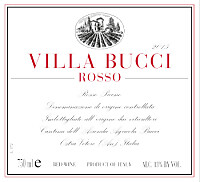
|
|
Rosso Piceno Villa Bucci 2015 |
|
| Villa Bucci (Marches, Italy) | |
 Montepulciano (70%), Sangiovese (30%) Montepulciano (70%), Sangiovese (30%) | |
| Price: € 30.00 | Score: |
 Intense ruby red and nuances of garnet red, little transparency. Intense ruby red and nuances of garnet red, little transparency. Intense, clean, pleasing, refined and elegant, starts with hints of
plum, black cherry and dried violet followed by aromas of blackberry,
blueberry, raspberry, tobacco, cocoa, leather, cinnamon, licorice, thyme,
laurel, vanilla and menthol. Intense, clean, pleasing, refined and elegant, starts with hints of
plum, black cherry and dried violet followed by aromas of blackberry,
blueberry, raspberry, tobacco, cocoa, leather, cinnamon, licorice, thyme,
laurel, vanilla and menthol.
 Properly tannic attack and however balanced by alcohol, good body,
intense flavors, pleasing roundness. Properly tannic attack and however balanced by alcohol, good body,
intense flavors, pleasing roundness.
 Persistent finish with flavors of plum, black cherry and blackberry. Persistent finish with flavors of plum, black cherry and blackberry. 1 year in cask, 6 months in bottle. 1 year in cask, 6 months in bottle. |
|
 Roasted meat, Stewed meat with mushrooms, Cheese Roasted meat, Stewed meat with mushrooms, Cheese |
|
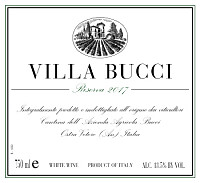
|
|
Castelli di Jesi Verdicchio Classico Riserva Villa Bucci 2017 |
|
| Villa Bucci (Marches, Italy) | |
 Verdicchio Verdicchio | |
| Price: € 48.00 | Score: |
 Brilliant straw yellow and nuances of straw yellow, very transparent. Brilliant straw yellow and nuances of straw yellow, very transparent. Intense, clean, pleasing, refined and elegant, starts with hints of
apple, plum and hawthorn followed by aromas of broom, chamomile, citrus
fruits, pear, peach, papaya, hazelnut, rosemary, honey, flint, almond and
hints of vanilla. Intense, clean, pleasing, refined and elegant, starts with hints of
apple, plum and hawthorn followed by aromas of broom, chamomile, citrus
fruits, pear, peach, papaya, hazelnut, rosemary, honey, flint, almond and
hints of vanilla.
 Crisp attack and however balanced by alcohol, good body, intense
flavors, agreeable. Crisp attack and however balanced by alcohol, good body, intense
flavors, agreeable.
 Very persistent finish with long flavors of apple, plum and almond. Very persistent finish with long flavors of apple, plum and almond. 18 months in cask, at least 6 months in bottle. 18 months in cask, at least 6 months in bottle. |
|
 Roasted fish, Roasted white meat, Stuffed pasta with fish, Cheese, Mushrooms soups Roasted fish, Roasted white meat, Stuffed pasta with fish, Cheese, Mushrooms soups |
|

|
|
I Ferretti Desiderium 2019 |
|
| Tenuta Luisa (Friuli-Venezia Giulia, Italy) | |
 Chardonnay, Friulano, Sauvignon Blanc Chardonnay, Friulano, Sauvignon Blanc | |
| Price: € 25.00 | Score: |
 Brilliant straw yellow and nuances of straw yellow, very transparent. Brilliant straw yellow and nuances of straw yellow, very transparent. Intense, clean, pleasing, refined and elegant, starts with hints of
apple, banana and citron followed by aromas of acacia, hawthorn, elder
flower, pear, grapefruit, plum, nettle, flint and hints of vanilla. Intense, clean, pleasing, refined and elegant, starts with hints of
apple, banana and citron followed by aromas of acacia, hawthorn, elder
flower, pear, grapefruit, plum, nettle, flint and hints of vanilla.
 Crisp attack and however balanced by alcohol, good body, intense
flavors, pleasing roundness. Crisp attack and however balanced by alcohol, good body, intense
flavors, pleasing roundness.
 Persistent finish with flavors of apple, banana and citron. Persistent finish with flavors of apple, banana and citron. Chardonnay aged in cask for 8 months, Friulano and Sauvignon Blanc in
steel tanks. Chardonnay aged in cask for 8 months, Friulano and Sauvignon Blanc in
steel tanks.
|
|
 Pasta with fish and crustaceans, Stewed fish with mushrooms, Sauteed white meat, Mushroom and vegetable soups Pasta with fish and crustaceans, Stewed fish with mushrooms, Sauteed white meat, Mushroom and vegetable soups |
|
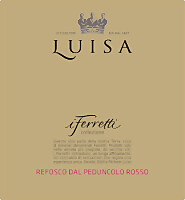
|
|
Refosco dal Peduncolo Rosso I Ferretti 2016 |
|
| Tenuta Luisa (Friuli-Venezia Giulia, Italy) | |
 Refosco dal Peduncolo Rosso Refosco dal Peduncolo Rosso | |
| Price: € 25.00 | Score: |
 Intense ruby red and nuances of garnet red, little transparency. Intense ruby red and nuances of garnet red, little transparency. Intense, clean, pleasing, refined and elegant, starts with hints of
black cherry, plum and blackberry followed by aromas of violet, blueberry,
raspberry, chocolate, tobacco, pink pepper, graphite, vanilla and menthol. Intense, clean, pleasing, refined and elegant, starts with hints of
black cherry, plum and blackberry followed by aromas of violet, blueberry,
raspberry, chocolate, tobacco, pink pepper, graphite, vanilla and menthol.
 Properly tannic attack and however balanced by alcohol, good body,
intense flavors, pleasing roundness. Properly tannic attack and however balanced by alcohol, good body,
intense flavors, pleasing roundness.
 Persistent finish with flavors of black cherry, plum and blackberry. Persistent finish with flavors of black cherry, plum and blackberry. 24 months in cask, 2 years in bottle. 24 months in cask, 2 years in bottle. |
|
 Roasted meat, Stewed meat with mushrooms, Cheese Roasted meat, Stewed meat with mushrooms, Cheese |
|
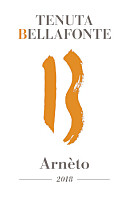
|
|
Arneto 2018 |
|
| Tenuta Bellafonte (Umbria, Italy) | |
 Trebbiano Spoletino Trebbiano Spoletino | |
| Price: € 18.00 | Score: |
 Intense golden yellow and nuances of golden yellow, very transparent. Intense golden yellow and nuances of golden yellow, very transparent. Intense, clean, pleasing, refined and elegant, starts with hints of
medlar, apple and citrus fruits followed by aromas of hawthorn, broom,
quince, mango, pear, peach, plum, apricot, oregano, butter, mineral and
vanilla. Intense, clean, pleasing, refined and elegant, starts with hints of
medlar, apple and citrus fruits followed by aromas of hawthorn, broom,
quince, mango, pear, peach, plum, apricot, oregano, butter, mineral and
vanilla.
 Crisp attack and however balanced by alcohol, good body, intense
flavors, pleasing roundness. Crisp attack and however balanced by alcohol, good body, intense
flavors, pleasing roundness.
 Persistent finish with flavors of medlar, quince and mango. Persistent finish with flavors of medlar, quince and mango. 12 months in cask, at least 5 months in bottle. 12 months in cask, at least 5 months in bottle. |
|
 Stuffed pasta with mushrooms, Stewed white meat, Roasted and stewed fish, Mushroom soups Stuffed pasta with mushrooms, Stewed white meat, Roasted and stewed fish, Mushroom soups |
|

|
|
Montefalco Sagrantino Collenottolo 2014 |
|
| Tenuta Bellafonte (Umbria, Italy) | |
 Sagrantino Sagrantino | |
| Price: € 30.00 | Score: |
 Intense ruby red and nuances of garnet red, little transparency. Intense ruby red and nuances of garnet red, little transparency. Intense, clean, pleasing, refined and elegant, starts with hints of
blackberry, plum and dried violet followed by aromas of black cherry,
blueberry, cocoa, tobacco, leather, cinnamon, mace, licorice, vanilla and
menthol. Intense, clean, pleasing, refined and elegant, starts with hints of
blackberry, plum and dried violet followed by aromas of black cherry,
blueberry, cocoa, tobacco, leather, cinnamon, mace, licorice, vanilla and
menthol.
 Properly tannic attack and however balanced by alcohol, full body,
intense flavors, pleasing roundness. Properly tannic attack and however balanced by alcohol, full body,
intense flavors, pleasing roundness.
 Persistent finish with flavors of blackberry, plum and black cherry. Persistent finish with flavors of blackberry, plum and black cherry. 36 months in cask, at least 12 moths in bottle. 36 months in cask, at least 12 moths in bottle. |
|
 Game, Roasted meat, Stewed and braised meat, Hard cheese Game, Roasted meat, Stewed and braised meat, Hard cheese |
|
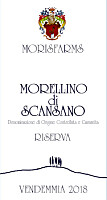
|
|
Morellino di Scansano Riserva 2018 |
|
| Moris Farms (Tuscany, Italy) | |
 Sangiovese (90%), Cabernet Sauvignon, Merlot (10%) Sangiovese (90%), Cabernet Sauvignon, Merlot (10%) | |
| Price: € 19.80 | Score: |
 Intense ruby red and nuances of garnet red, little transparency. Intense ruby red and nuances of garnet red, little transparency. Intense, clean, pleasing and refined, starts with hints of black
cherry, plum and dried violet followed by aromas of geranium, blueberry,
blackberry, black currant, chocolate, tobacco, vanilla and menthol. Intense, clean, pleasing and refined, starts with hints of black
cherry, plum and dried violet followed by aromas of geranium, blueberry,
blackberry, black currant, chocolate, tobacco, vanilla and menthol.
 Properly tannic attack and however balanced by alcohol, good body,
intense flavors, pleasing roundness. Properly tannic attack and however balanced by alcohol, good body,
intense flavors, pleasing roundness.
 Persistent finish with flavors of black cherry, plum and blueberry. Persistent finish with flavors of black cherry, plum and blueberry. 12 months in barrique, 6 months in bottle. 12 months in barrique, 6 months in bottle. |
|
 Broiled meat and barbecue, Roasted meat, Stewed and braised meat with mushrooms, Hard cheese Broiled meat and barbecue, Roasted meat, Stewed and braised meat with mushrooms, Hard cheese |
|
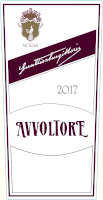
|
|
Avvoltore 2017 |
|
| Moris Farms (Tuscany, Italy) | |
 Sangiovese (75%), Cabernet Sauvignon (20%), Syrah (5%) Sangiovese (75%), Cabernet Sauvignon (20%), Syrah (5%) | |
| Price: € 33.50 | Score: |
 Intense ruby red and nuances of ruby red, little transparency. Intense ruby red and nuances of ruby red, little transparency. Intense, clean, pleasing, refined and elegant, starts with hints of
black currant, black cherry and plum followed by aromas of violet, peony,
rose, blueberry, raspberry, cocoa, tobacco, mace, cinnamon, face powder,
vanilla and eucalyptus. Intense, clean, pleasing, refined and elegant, starts with hints of
black currant, black cherry and plum followed by aromas of violet, peony,
rose, blueberry, raspberry, cocoa, tobacco, mace, cinnamon, face powder,
vanilla and eucalyptus.
 Properly tannic attack and however balanced by alcohol, full body,
intense flavors, pleasing roundness. Properly tannic attack and however balanced by alcohol, full body,
intense flavors, pleasing roundness.
 Very persistent finish with flavors of black currant, black cherry and
plum. Very persistent finish with flavors of black currant, black cherry and
plum.
 12 months in barrique, 6 months in bottle. 12 months in barrique, 6 months in bottle. |
|
 Game, Roasted meat, Braised and stewed meat, Hard cheese Game, Roasted meat, Braised and stewed meat, Hard cheese |
|
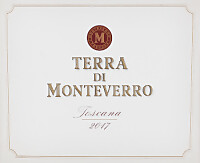
|
|
Terra di Monteverro 2017 |
|
| Monteverro (Tuscany, Italy) | |
 Cabernet Sauvignon (40%), Cabernet Franc (35%), Merlot (20%), Petit Verdot (5%) Cabernet Sauvignon (40%), Cabernet Franc (35%), Merlot (20%), Petit Verdot (5%) | |
| Price: € 42.00 | Score: |
 Deep ruby red and nuances of ruby red, little transparency. Deep ruby red and nuances of ruby red, little transparency. Intense, clean, pleasing, refined and elegant, starts with hints of
black currant, black cherry and violet followed by aromas of iris, plum,
blueberry, cocoa, tobacco, face powder, licorice, leather, vanilla and
eucalyptus. Intense, clean, pleasing, refined and elegant, starts with hints of
black currant, black cherry and violet followed by aromas of iris, plum,
blueberry, cocoa, tobacco, face powder, licorice, leather, vanilla and
eucalyptus.
 Properly tannic attack and however balanced by alcohol, full body,
intense flavors, pleasing roundness. Properly tannic attack and however balanced by alcohol, full body,
intense flavors, pleasing roundness.
 Persistent finish with flavors of black currant, black cherry and plum. Persistent finish with flavors of black currant, black cherry and plum. 20 months in barrique. 20 months in barrique. |
|
 Game, Roasted meat, Stewed and braised meat, Hard cheese Game, Roasted meat, Stewed and braised meat, Hard cheese |
|
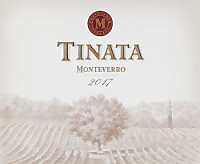
|
|
Tinata 2017 |
|
| Monteverro (Tuscany, Italy) | |
 Syrah (70%), Grenache Noir (30%) Syrah (70%), Grenache Noir (30%) | |
| Price: € 96.00 | Score: |
 Deep ruby red and nuances of ruby red, little transparency. Deep ruby red and nuances of ruby red, little transparency. Intense, clean, pleasing, refined and elegant, starts with hints of
black currant, black cherry and blueberry followed by aromas of violet,
carnation, lavender, plum, raspberry, cocoa, tobacco, black pepper, mace,
thyme, vanilla and eucalyptus. Intense, clean, pleasing, refined and elegant, starts with hints of
black currant, black cherry and blueberry followed by aromas of violet,
carnation, lavender, plum, raspberry, cocoa, tobacco, black pepper, mace,
thyme, vanilla and eucalyptus.
 Properly tannic attack and however balanced by alcohol, full body,
intense flavors, pleasing roundness. Properly tannic attack and however balanced by alcohol, full body,
intense flavors, pleasing roundness.
 Persistent finish with flavors of black currant, black cherry and
blueberry. Persistent finish with flavors of black currant, black cherry and
blueberry.
 16 month in barrique and cement tanks. 16 month in barrique and cement tanks. |
|
 Game, Roasted meat, Stewed and braised meat, Cheese Game, Roasted meat, Stewed and braised meat, Cheese |
|
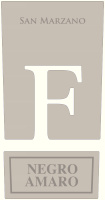
|
|
Negroamaro F 2019 |
|
| San Marzano (Apulia, Italy) | |
 Negroamaro Negroamaro | |
| Price: € 24.90 | Score: |
 Deep ruby red and nuances of ruby red, little transparency. Deep ruby red and nuances of ruby red, little transparency. Intense, clean, pleasing, refined and elegant, starts with hints of
black cherry, blackberry and plum followed by aromas of violet, blueberry,
carob, tobacco, chocolate, licorice, mace, vanilla and menthol. Intense, clean, pleasing, refined and elegant, starts with hints of
black cherry, blackberry and plum followed by aromas of violet, blueberry,
carob, tobacco, chocolate, licorice, mace, vanilla and menthol.
 Properly tannic attack and however balanced by alcohol, good body,
intense flavors, pleasing roundness. Properly tannic attack and however balanced by alcohol, good body,
intense flavors, pleasing roundness.
 Persistent finish with flavors of black cherry, blackberry and plum. Persistent finish with flavors of black cherry, blackberry and plum. 12 months in barrique. 12 months in barrique. |
|
 Stuffed pasta with meat and mushrooms, Broiled meat and barbecue, Stewed meat with mushrooms, Roasted meat, Cheese Stuffed pasta with meat and mushrooms, Broiled meat and barbecue, Stewed meat with mushrooms, Roasted meat, Cheese |
|
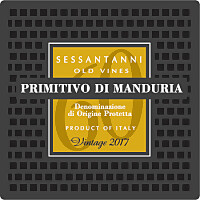
|
|
Primitivo di Manduria Sessantanni 2017 |
|
| San Marzano (Apulia, Italy) | |
 Primitivo Primitivo | |
| Price: € 26.90 | Score: |
 Deep ruby red and nuances of garnet red, little transparency. Deep ruby red and nuances of garnet red, little transparency. Intense, clean, pleasing, refined and elegant, starts with hints of
blackberry, black cherry and plum followed by aromas of violet, blueberry,
carob, chocolate, face powder, tobacco, cinnamon, pink pepper, leather,
vanilla and menthol. Intense, clean, pleasing, refined and elegant, starts with hints of
blackberry, black cherry and plum followed by aromas of violet, blueberry,
carob, chocolate, face powder, tobacco, cinnamon, pink pepper, leather,
vanilla and menthol.
 Properly tannic attack and however balanced by alcohol, full body,
intense flavors, pleasing roundness. Properly tannic attack and however balanced by alcohol, full body,
intense flavors, pleasing roundness.
 Very persistent finish with long flavors of blackberry, black cherry
and plum. Very persistent finish with long flavors of blackberry, black cherry
and plum.
 At least 12 months in barrique. At least 12 months in barrique. |
|
 Game, Roasted meat, Braised and stewed meat, Hard cheese Game, Roasted meat, Braised and stewed meat, Hard cheese |
|
|
||||||||
|
DiWineTaste Polls
|
| |||||||
Privacy Policy | |||||||


| Copyright © 2002-2024 Antonello Biancalana, DiWineTaste - All rights reserved |
| All rights reserved under international copyright conventions. No part of this publication and of this WEB site may be
reproduced or utilized in any form or by any means, electronic or mechanical, without permission in writing from DiWineTaste. |